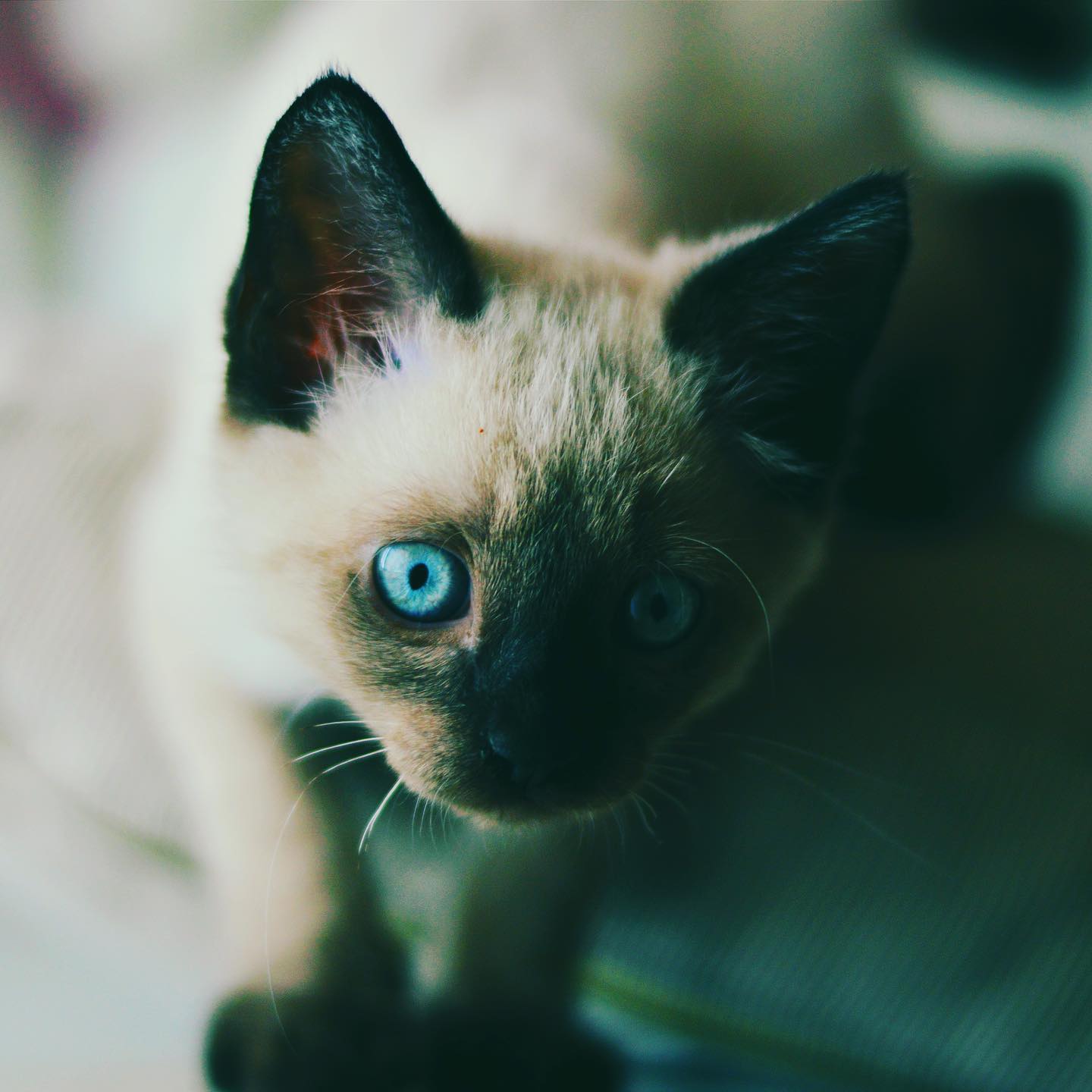Every cat owner knows the heart-stopping moment when your curious feline decides to explore a new houseplant. The worry of potential toxicity can turn plant ownership into a nerve-wracking experience. With bromeliads becoming increasingly popular in home decor, understanding their safety around cats is crucial.
Good news for plant enthusiasts! Bromeliads are actually considered non-toxic to cats, offering a breath of relief for pet owners concerned about bromeliad toxic to cats scenarios. The ASPCA confirms that these vibrant plants are safe for your furry companions, making them an excellent choice for cat-friendly households.
While many common houseplants pose risks, cat safe bromeliad varieties stand out as a smart option for pet owners who love indoor greenery. These tropical plants not only add visual interest to your home but also provide peace of mind that your curious cat can explore without immediate danger.
As we dive deeper into the world of bromeliads and cat safety, you’ll discover everything you need to know about keeping your feline friend protected while enjoying beautiful indoor plants.
Table of Contents
Understanding Bromeliads and Their Varieties
Bromeliads are amazing tropical plants that can brighten up your home. They come in over 3,940 species, offering a wide range for those who love plants and want pet-friendly options.
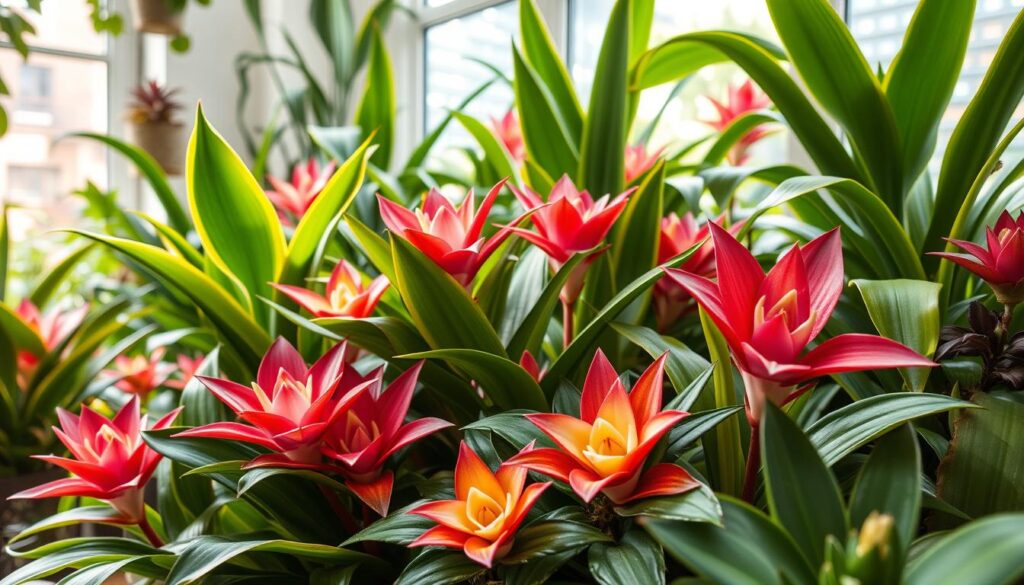
What Are Bromeliads?
Bromeliads are plants that grow on other surfaces. They have striking leaves and can produce colorful bracts that last for months. These plants are not inherently bromeliad toxic to cats, making them great for pet owners who also love plants.
Popular Types of Bromeliads
- Guzmania: Known for bright red and orange bracts
- Neoregelia: Offers diverse leaf colors and patterns
- Vriesea: Features sword-like flower spikes
Each type of bromeliad adds something special to your home. For example, Guzmania species like G. lingulata bloom for 2 to 4 months, adding beauty for a long time.
Where Do Bromeliads Thrive?
Bromeliads do well in certain conditions. They like:
- Indoor temperatures between 60-85°F
- Humidity levels of 40-50%
- Indirect light
- Well-draining soil mixture
“Bromeliads are not just plants, they’re living art that can coexist beautifully with your feline companions.”
When adding bromeliads to your home, remember they can be safe for cats. But always watch how your pet interacts with new plants.
The Toxicity of Bromeliads to Cats
Cat owners often wonder about the safety of plants in their home. When it comes to bromeliad toxicity in felines, the news is mostly good. The bromeliad family, which consists of over 3,940 species, is generally considered safe for your feline friends.
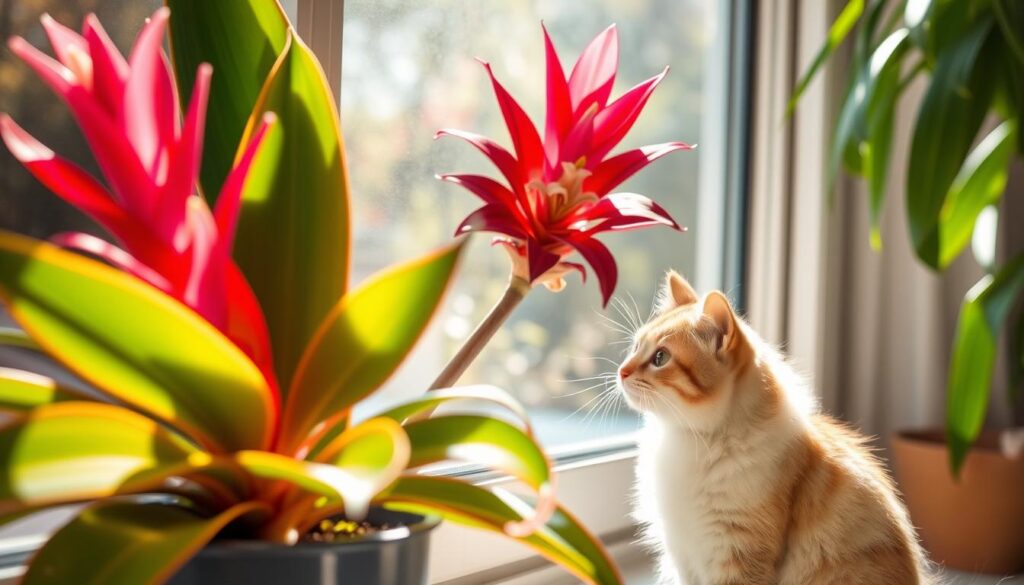
The ASPCA classifies bromeliads as non-toxic to cats. This doesn’t mean cats can freely munch on these plants without any consequences. While not poisonous, excessive consumption can lead to mild digestive issues.
Are Bromeliads Poisonous to Cats?
Bromeliad toxicity in felines is relatively low. Cats may experience minor symptoms if they eat large quantities of bromeliad leaves or roots:
- Mild stomach upset
- Potential vomiting
- Possible diarrhea
Common Symptoms of Bromeliad Poisoning
Symptoms of bromeliad poisoning in cats are typically mild and may include:
- Occasional vomiting
- Soft or loose stools
- Temporary loss of appetite
- Mild lethargy
“While bromeliads are generally safe, always monitor your cat’s interaction with any houseplant.” – Veterinary Plant Safety Guide
Identifying Toxic Bromeliad Varieties
Most bromeliad species are safe, but it’s crucial to watch your cat’s behavior. Research indicates that cats not mentally stimulated may engage more with houseplants, increasing the risk of plant material ingestion.
If you notice persistent symptoms or significant changes in your cat’s health after plant interaction, contact your veterinarian immediately.
Safe Indoor Plants for Cat Owners
Having cats and loving plants is possible. Many houseplants are safe for cats and can make your home beautiful.
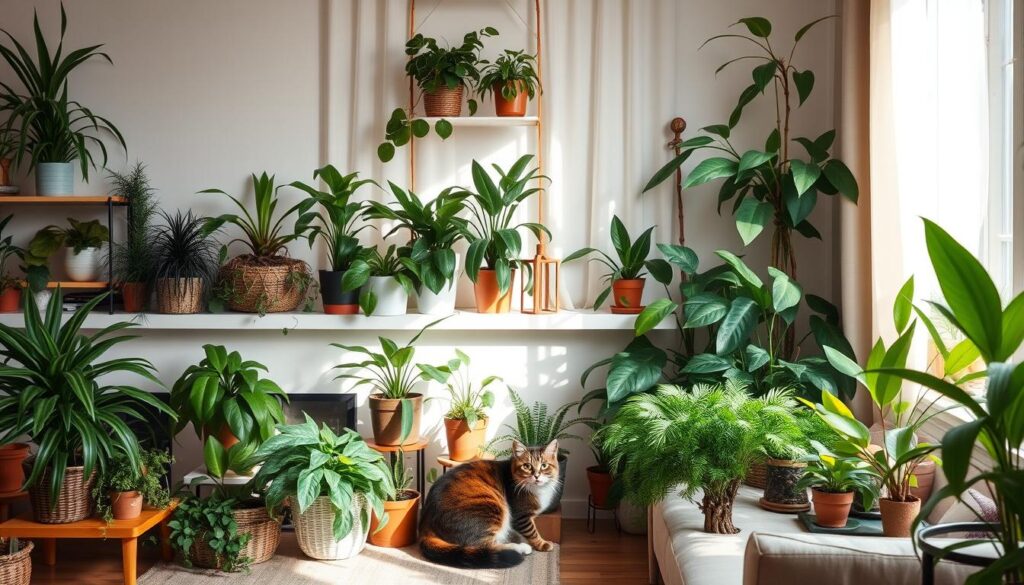
Choose plants that are safe for cats. These plants won’t harm your pets if they explore them.
Non-Toxic Alternatives to Bromeliads
There are many beautiful, safe plants instead of bromeliads:
- Spider Plant – 100% non-toxic
- Boston Fern – Safe for curious cats
- Areca Palm – Pet-friendly option
- Parlor Palm – Completely safe
- Peperomia – Zero toxicity risk
How to Choose Cat-Friendly Houseplants
Choosing the right plants for your home needs thought. Always check if a plant is safe before buying it.
| Plant Name | Pet Safety | Care Level |
|---|---|---|
| Spider Plant | 100% Non-Toxic | Easy |
| Boston Fern | Safe | Moderate |
| Orchids | Non-Toxic | Intermediate |
“Your cat’s safety should always be the top priority when selecting indoor plants.” – Veterinary Plant Safety Association
Check the ASPCA’s list of safe plants before getting a new one. Remember, every cat is different. Watch how your cat reacts to new plants.
Pro tip: Place plants in areas less accessible to cats, and consider hanging planters for additional safety.
Caring for Bromeliads in Your Home
Bromeliads are fascinating plants that can add vibrant color and unique texture to your living space. With over 3,940 species existing worldwide, these plants offer diverse options for indoor gardening while keeping pet safety in mind.
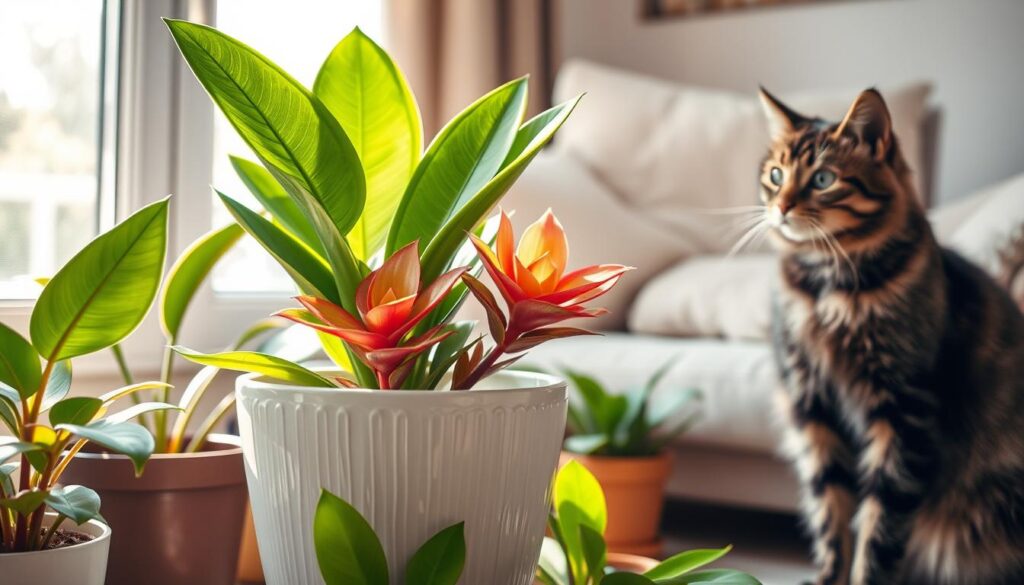
When considering bromeliads in a home with cats, understanding their specific care requirements is crucial for both plant and pet-friendly gardening.
Essential Care Tips for Bromeliads
- Provide bright, indirect light for optimal growth
- Water sparingly, allowing soil to dry between waterings
- Maintain consistent room temperatures between 60-80°F
- Use well-draining potting mix specifically for bromeliads
Common Mistakes in Bromeliad Care
Pet owners should avoid these typical bromeliad care errors:
- Overwatering, which can lead to root rot
- Placing plants in direct sunlight
- Using standard fertilizers inappropriate for bromeliads
- Neglecting proper drainage
Signs of a Healthy Bromeliad
Recognize a thriving bromeliad with these indicators:
| Indicator | Healthy Sign |
|---|---|
| Leaf Color | Vibrant, consistent green or colorful |
| Central Cup | Clean, free from debris |
| Growth Pattern | Steady, symmetrical development |
“Successful bromeliad care is about understanding the plant’s unique needs while maintaining a safe environment for your feline companions.”
While bromeliads are generally considered non-toxic to cats, pet-friendly gardening requires careful monitoring. Cats might experience mild digestive issues if they consume large quantities of the plant. Always position bromeliads out of your cat’s immediate reach to prevent potential interactions.
How to Keep Your Cat Safe Around Plants
Pet owners face a unique challenge when decorating their homes with plants. Cats are naturally curious, often exploring by touch and taste. This curiosity can put them at risk around toxic plants.
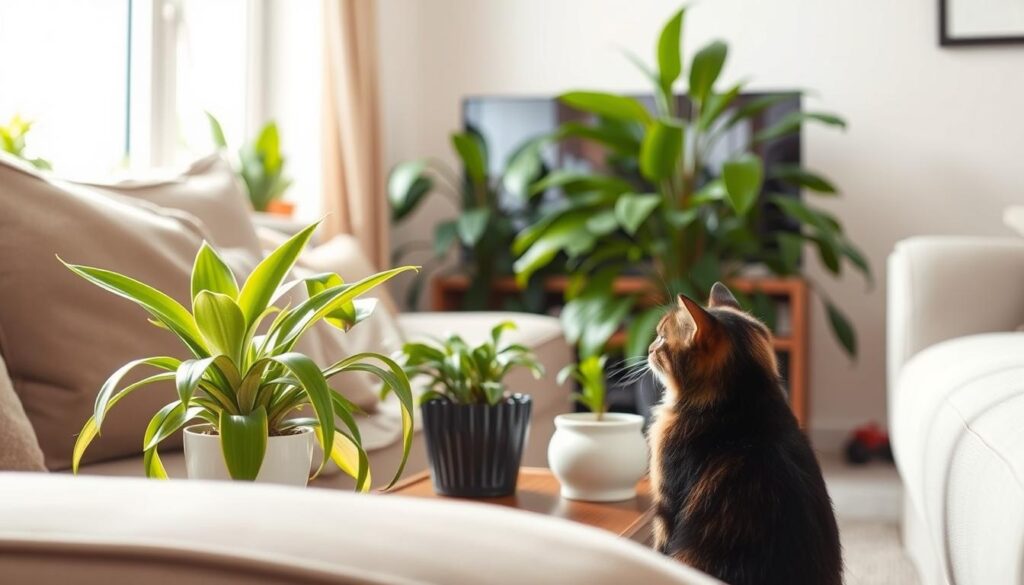
To keep cats safe from toxic plants, you need a strategic approach. This includes prevention and careful plant selection. Understanding how to avoid poisonous plants is crucial for pet owners’ peace of mind.
Preventing Cat-Plant Interactions
Protecting your feline friend from harmful plants requires several strategies:
- Place plants in elevated areas inaccessible to cats
- Use physical barriers like hanging baskets
- Create dedicated plant zones with restricted cat access
- Choose non-toxic plant varieties
Creating a Safe Plant Environment
| Plant Safety Strategy | Implementation Method |
|---|---|
| Elevated Placement | Use high shelves or wall-mounted planters |
| Physical Barriers | Install protective screens or decorative fencing |
| Plant Selection | Choose ASPCA-approved non-toxic plants |
Pro tip: Always research plant toxicity before bringing new greenery into your home.
“Prevention is always better than cure when it comes to pet safety.” – Veterinary Experts
By implementing these strategies, you can create a safe environment. This allows both your plants and cats to thrive together. Remember, vigilance and proactive planning are key to protecting your pet from plant-related hazards.
What to Do If Your Cat Is Poisoned
Plant poisoning can be very scary for cat owners. Knowing the symptoms of bromeliad poisoning in cats and acting fast is key. It can save your pet’s health and safety.
The symptoms of bromeliad toxicity in cats can vary. Spotting these signs early is vital for your cat’s health.
Immediate First Aid Steps
If you think your cat has eaten a toxic plant, act quickly:
- Remove any plant material from your cat’s mouth
- Rinse your cat’s mouth gently with water
- Collect a sample of the plant for identification
- Watch for these critical symptoms:
- Excessive drooling
- Vomiting
- Difficulty breathing
- Lethargy
When to Contact Your Veterinarian
“Quick action can be lifesaving in cases of plant poisoning” – Veterinary Emergency Specialists
Call your vet right away if you see:
- Persistent vomiting
- Signs of severe distress
- Continuous drooling
- Visible pain or discomfort
Bromeliad toxicity in cats can get worse fast. Getting your cat to a vet quickly is crucial. Always put your cat’s health first and seek help when unsure.
The Importance of Knowing Plant Toxicity
It’s key for pet owners to know about plant toxicity to keep their homes safe. Cats are curious and might get into trouble with toxic plants. Knowing which plants are safe can save your cat’s life.

Pet owners should learn about safe plants for homes with cats. Toxic plants can harm your cat’s health badly.
Understanding Plant Safety for Pets
When picking houseplants, think about these important points:
- Research each plant’s potential toxicity
- Consult veterinary resources before bringing new plants home
- Learn to identify warning signs of plant poisoning
- Keep potentially dangerous plants out of your cat’s reach
Resources for Plant Toxicity Information
There are reliable sources for plant safety info:
| Resource | Type of Information | Accessibility |
|---|---|---|
| ASPCA Toxic Plants Database | Comprehensive plant toxicity list | Online, Free |
| Veterinary Poison Control | Emergency plant toxicity guidance | Phone/Online Support |
| Veterinary Websites | Detailed plant safety information | Online, Frequently Updated |
“Knowledge is the best protection when it comes to keeping your pets safe from toxic plants.” – Veterinary Pet Safety Expert
Remember, prevention is always better than treatment when it comes to protecting your beloved cats from potential plant-related health risks.
Will Cat Behavior Change Around Plants?
It can be tricky to understand how cats relate to houseplants. Cats are naturally curious and have complex ways of interacting with their surroundings. When you bring in new cat-friendly plants, you might see small changes in their behavior.
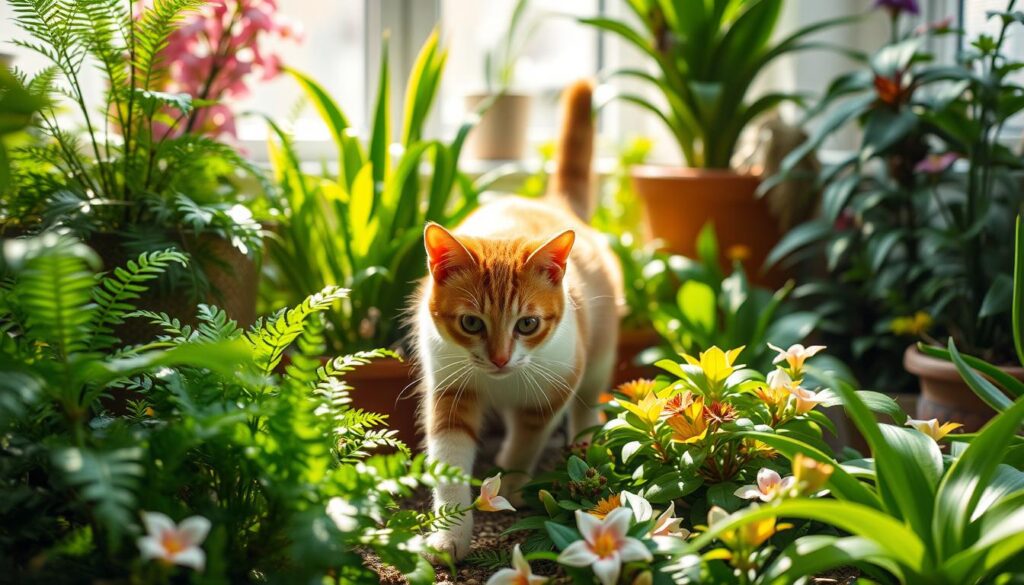
- Exploring new textures and scents
- Potential digestive relief
- Marking territory
- Seeking attention
Understanding Feline Curiosity
Cats see plants as things to play with. They like to sniff, bat, and sometimes nibble on them. This isn’t always bad, but it needs careful handling when gardening with pets in mind.
“Cats are natural explorers. What seems like random plant interaction is often a sophisticated sensory investigation.” – Feline Behavior Expert
How to Manage Your Cat’s Interest
To keep your plants and cat safe, you need to take steps:
- Create designated plant zones
- Use deterrent sprays
- Provide alternative stimulation
- Choose cat-safe plant varieties
By understanding and guiding your cat’s curiosity, you can make a safe space for both plants and pets.
Educating Other Cat Owners About Plant Safety
Keeping our cats safe from harmful plants is a team effort. By sharing what we know about bromeliads and cats, we can avoid risks. This helps keep pets safe in many homes.
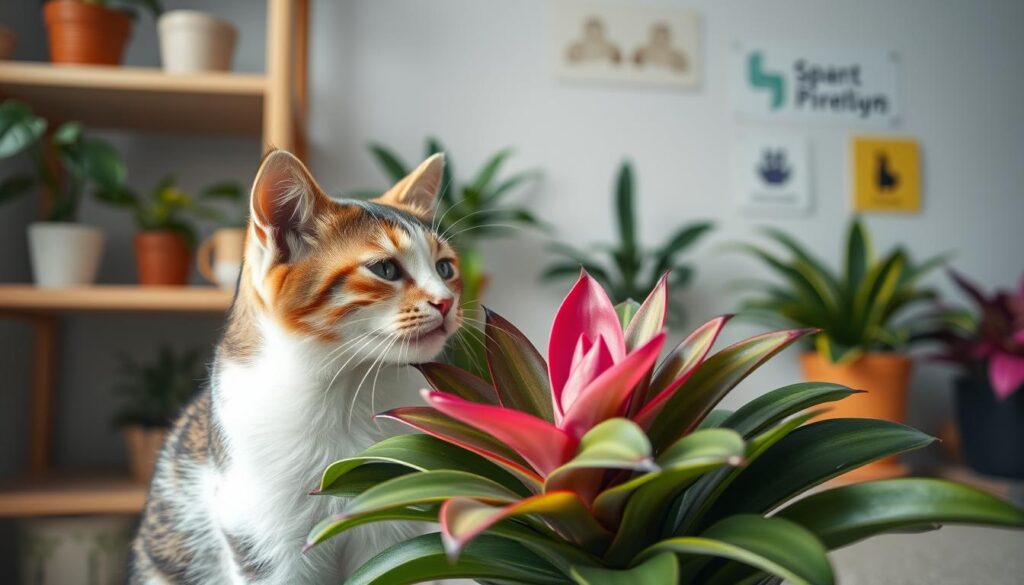
Cat owners can make a big difference by teaching others about dangerous plants. Sharing what we know helps prevent emergencies and keeps pets safe.
Strategies for Sharing Plant Safety Information
- Discuss plant toxicity during social gatherings
- Share reliable resources on social media platforms
- Create informative digital materials for local pet groups
- Connect with veterinary clinics to distribute safety guides
Local Resources for Cat Owners
| Resource Type | Contact Method | Information Provided |
|---|---|---|
| Local Veterinary Clinics | Phone/Email | Plant toxicity consultations |
| Pet Owner Support Groups | Online Forums | Community plant safety tips |
| Animal Poison Control | 24/7 Hotline | Emergency plant toxicity guidance |
By getting involved in education, we can make our community safer for cats. Awareness is the first step to avoiding health problems from plants.
“Knowledge shared is protection multiplied” – Veterinary Safety Motto
Teaching others about plant dangers can save lives. It also helps avoid unnecessary vet visits.
The Role of Veterinarians in Plant Toxicity
Veterinarians are key in keeping your cat safe from plants. They know a lot about how plants can harm cats. This goes beyond just knowing about plants.
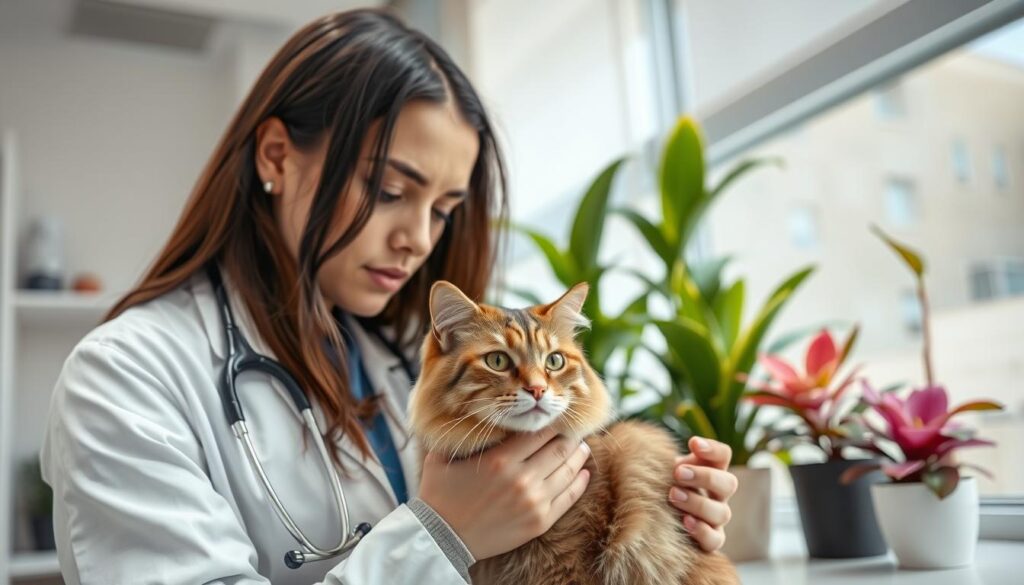
Vets are your best source for checking if plants are safe for your cat. They have special training to spot dangers from plants.
How Veterinarians Assess Plant Toxicity
Vets use a careful method to check if plants are toxic:
- They look at your cat’s health history
- They do a physical check-up
- They study the plant’s type
- They figure out if your cat could get sick from it
Questions to Ask Your Veterinarian
Make a list of important questions to ask your vet about plants:
- What plants are bad for cats?
- How can I tell if a plant is toxic?
- What should I do if my cat eats a bad plant?
- Are there ways to keep my cat safe from plants?
“Knowledge is the best protection when it comes to keeping your feline friend safe from plant-related risks.” – Veterinary Plant Safety Expert
In 2021, the ASPCA said over 400,000 pets got poisoned, with 20% from plants. This shows why you should talk to vets about plant safety.
Even though bromeliads are usually safe, a vet can tell you more. They can help keep your cat safe.
Additional Resources on Bromeliads and Cats
Finding cat safe bromeliad varieties and safe plants for homes with cats can be tough. Luckily, many resources are available to help pet owners choose the right indoor plants.
Online Databases for Plant Toxicity
There are several online resources that give important info on plant safety for pets:
- ASPCA Animal Poison Control Center Database
- Pet Poison Helpline’s Online Plant Guide
- American Veterinary Medical Association (AVMA) Plant Safety Resources
Recommended Books and Websites
Learn more about safe plants and cat interactions with these expert-recommended resources:
| Resource Type | Name | Focus Area |
|---|---|---|
| Book | The Cat-Friendly Houseplant Guide | Plant Safety for Cats |
| Website | PetMD Plant Safety Section | Comprehensive Plant Toxicity Information |
| Online Database | Cornell Feline Health Center | Veterinary-Backed Plant Research |
“Knowledge is the best protection for your feline friends.” – Veterinary Plant Safety Expert
Digital Tools for Plant Safety
Modern tech offers new ways to keep plants safe. Mobile apps like Pet Plant Safe give quick info on plant risks. They help you make a safe space for your cats.
While these resources are very helpful, always talk to your vet. They can give advice tailored to your home and cat’s needs.
Myths About Bromeliads and Cats
Plant myths can worry cat owners too much. Knowing the truth about bromeliads and cats helps you choose safe houseplants.
Many cat owners think bromeliads are very dangerous. Let’s look at some common myths and find out what’s true.
Debunking Common Misconceptions
- Myth: All bromeliads are extremely dangerous to cats
- Reality: Most bromeliads are actually considered non-toxic to cats
- Myth: Cats will definitely get sick if they touch a bromeliad
- Reality: While caution is recommended, not all plant interactions result in poisoning
What Cat Owners Should Understand
Bromeliads can be a safe choice for cat-friendly houseplants. The ASPCA says most bromeliad varieties are non-toxic, posing little risk to cats.
“Knowledge is the best protection when it comes to plants and pet safety” – Veterinary Plant Toxicity Expert
Key Insights for Cat Owners
- Always research specific plant varieties
- Consult with veterinarians about potential risks
- Monitor your cat’s interactions with any houseplant
- Choose plants mindfully for pet-safe environments
About 60% of cat owners look for non-toxic plants like bromeliads. By knowing the facts, you can have a safe and lovely indoor garden for both you and your cat.
Conclusion: Keeping Your Cats Safe
Keeping cats safe from toxic plants is a big job. With over 3,940 bromeliad species, owners must watch out for dangers at home. Even though most bromeliads are safe, some cats might react differently.
Start by learning about safe plants for pets. The ASPCA suggests looking up each plant’s safety before bringing it home. Choose cat-safe options like African Violet or Spider Plant. This way, you can keep your cat healthy and happy.
Final Thoughts on Bromeliad Toxicity
Keeping your cat safe means picking the right plants and watching them closely. Make sure your cat gets enough exercise and mental play. This way, they won’t be tempted by dangerous plants. A safe home is where both pets and plants can live well together.
Importance of Plant Awareness for Cat Owners
Being a good pet owner means knowing about dangers. Whether you have bromeliads or other plants, knowing their risks is key. Always talk to your vet and be ready to act fast if your cat shows signs of illness after touching a plant.

